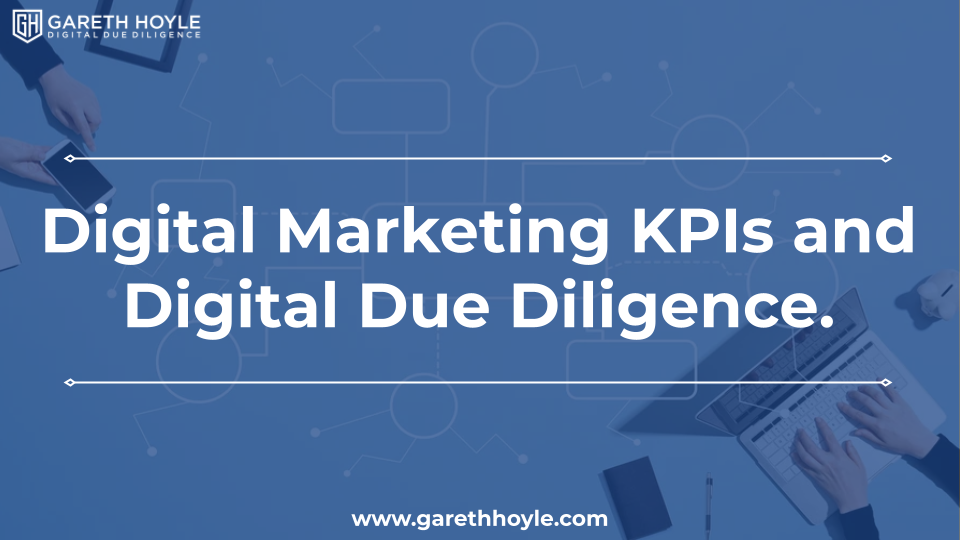Digital due diligence is a comprehensive assessment of a company’s digital assets. Part of the digital due diligence process is the analysis of relevant Key Performance Indicators (KPIs), the outcome of which is an honest appraisal of marketing strategy effectiveness. Tracking and reporting the correct KPIs requires a dedicated and bespoke approach.
Benefits of digital due diligence KPIs:
- Analyse and improve the performance of your current digital assets
- Drive the decision over whether to acquire a third-party website
Digital due diligence KPIs typically report on metrics selected for relevance. Do the KPIs move the needle where it counts? Have relevant metrics been overlooked? Has investment in vanity metrics resulted in wasted spend? Let’s take a closer look at KPIs.
Jump Sections
What are KPIs (and why do we need them?)
A Key Performance Indicator (KPI) is a quantifiable metric used to evaluate marketing strategy effectiveness. KPIs highlight the reality of whether current strategies deliver goal-aligned outcomes. KPIs help us to make better decisions over resource allocation, including budget and expense management.
KPI insights include:
- Raw data – where do the numbers stand today?
- Strategy effectiveness over time – how have strategies correlated with progress?
- Changes required to align with specified business goals – where are the failings?
Next, we must understand how to derive relevant KPIs.
OKRs vs KPIs (what’s the difference?)
When selecting and measuring KPIs at the asset acquisition stage, the most relevant metrics will likely differ from the KPIs chosen to help audit an existing in-house website. The difference lies in the Objective and Key Results (OKR).
OKRs form the goal-oriented frameworks that help us to define relevant KPIs.
For example, a common objective is to boost conversion rates, but an analysis of customer touchpoint interactions may reveal low audience volumes. In this case, KPIs such as the average order value per customer will not teach us anything about how we could better drive engagement. Digital due diligence can help us to understand OKR and choose relevant KPIs.
KPIs at Different Stages of Asset Ownership
Depending on factors such as the size of the company and core business goals, KPIs will vary. Broadly speaking, digital due diligence KPIs comprise three main pillars:
- Customer Acquisition (e.g., return on ad spend, customer lifetime value, channels used to access the site, etc.)
- Liquidity (e.g., whether clients pay on time, burn rate vs working capital, etc.)
- Profitability (e.g., the relationship between revenue, expenses, & profit)
Let’s look at how to apply digital due diligence in isolating KPIs across the different stages of business ownership and development.
KPIs at the Business Acquisition Stage
Customer acquisition begins with creating brand awareness at the top of the funnel. Multiple channels can help to deliver greater brand awareness. For example, channels may include PPC advertising, optimised web content (SEO), natural and paid social media, influencers, and retargeting.
Digital due diligence can help to assess the effectiveness of these different channels in acquiring customers.
KPIs at the acquisition stage may include:
- Bounce rate
- Website traffic
- Pages by views
- Time on site (dwell time)
- CTA (on-page position and relevance)
Tracking Channels (Analyse – Report – Decide)
Digital due diligence can help to uncover how the team analyses metrics. Educating staff members on how to interpret results and implement best-practice techniques can drive success.
KPIs in tracking channels, analysing data, reporting, and decision making may include:
- How does the team track campaigns across channels?
- How is the data applied to retention and loyalty models?
- Which reporting tools are in use, and is training required?
- Are the correct channels in use relevant to the service or product?
- What are the standard procedures for creating marketing campaigns?
KPIs at the Retention Stage
Digital due diligence KPIs at the retention stage must focus on whether acquisition marketing techniques produce results that align with company goals, marketing budgets, and expected ROI.
KPIs at the retention stage may include:
- Purchase frequency
- Campaign lifecycle setup
- Marketing clicks (e.g., ads/emails)
- Repeat visits (and time between visits)
- Interaction with loyalty and VIP packages
Scale Your Business – Digital Due Diligence KPIs (Beyond Sales)
Not all KPIs should focus on factors directly related to acquisition and growth. Digital due diligence must also include KPIs that highlight customer experience.
For example, a company-wide deep dive into the tech stack can reveal flaws in the current IT solution. A poor setup could affect user experience and prevent the business from scaling to meet demand.
KPIs at the technology level may include:
- Website security
- Server performance and downtime reports
- Technology obsolescence & redundancy planning
- Availability of on-hand tech support and training for staff members
To discuss how digital due diligence KPIs can help you, get in touch today. Remember, the initial conversation is FREE.
